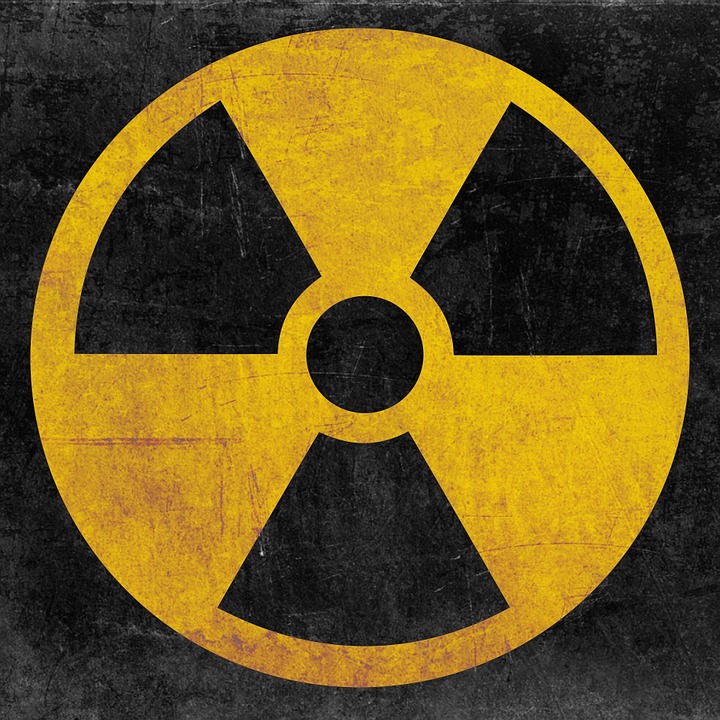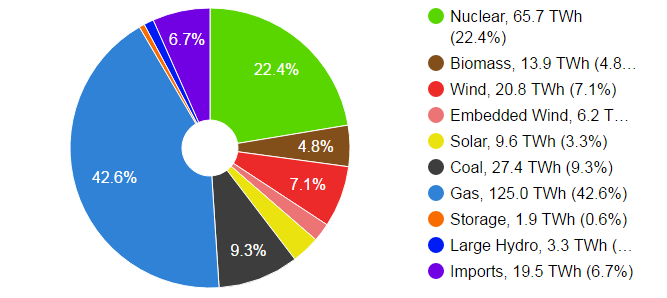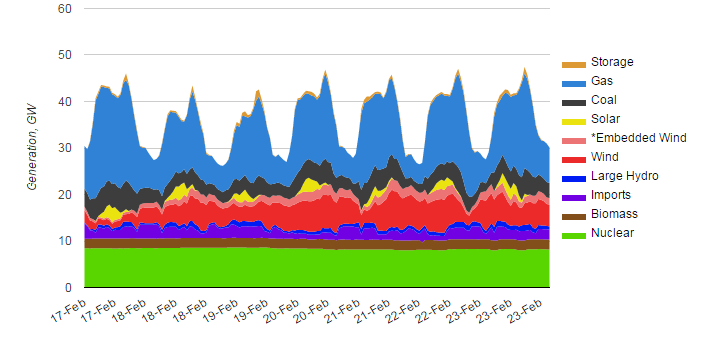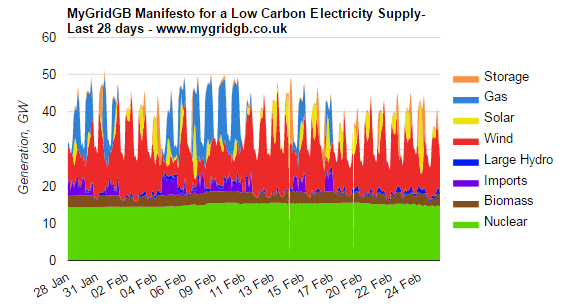
In this articles I focus on nuclear power – something which rarely features in my blogs, but which is a big component of the MyGridGB manifesto.
Nuclear power is low carbon generation according to the Intergovernmental Panel on Climate Change (IPCC): the source of carbon emission values on this website. The IPCC accounts the full lifecycle of a nuclear plant including the carbon emissions embedded in construction and decommissioning.
Nuclear power does provide Great Britain with a steady source of low carbon electricity. Between March and December 2016, Britain’s nuclear power stations produced between 6.3 and 8.8 GW of electricity and provided around 22% of our electricity.
Britain has 15 nuclear reactors with a total capacity of around 8.8 GW. Half of these will be decomissioned by 2025 and they are planned to be replaced with 17.9 GW of new plants. Nuclear power in the UK is not likely go away soon.
British Electricity Sources: February 2016 to February 2017 – www.mygridgb.co.uk

When running, nuclear plants provide a steady baseload of power. However, they have a number of flaws one of which I focus on here: they do not like to be switched off. This means that there must be sufficient demand for electricity for them to power. This becomes a problem at night or at weekends when electricity demand falls to its lowest levels.
The difference in demand between night and day is clearly visible in the chart below which shows electricity generation between 16th and 22nd February 2017. On weekdays, electricity generation is usually above 40GW but at night this week it fell as low as 26GW.

At night, National Grid must ensure that there will be sufficient demand to take the nuclear power. Economy 7 tariffs, pumped storage plants were designed in part to provide overnight demand whist Britain slept to take nuclear power and keep the nuclear power stations on.
As a result, there is a limit on the amount of nuclear stations which can be built: which in part limits the amount of nuclear in my manifesto. For example, as you can see in the chart, on the night of 21st February there was less than 11 GW difference between what nuclear, wind and hydro were producing and what the country was consuming. This in essence meant that, without demand increase, Britain couldn’t have more than 11 GW of additional nuclear power stations this week.
Unless there is significant change in our demand pattern or advances in nuclear generation technology, the amount of nuclear power stations that Britain can build is limited by the amount of electricity consumed at night. Quite simply, if Britain has 20GW of nuclear power stations running, National Grid need to be confident that we will demand 20GW of electricity (and can turn off all of the wind turbines, solar inverters, hydro dams etc.).
The advent of electric vehicles (charging at night), more pumped hydro or storage heaters will permit more nuclear power stations. This isn’t unrealistic. France, where Nuclear contributes over 65% of electricity has a much flatter demand profile: there as big a difference between electricity during the day and at night or weekdays and weekends. This means that more nuclear power can be accommodated. For reference, the British and French electricity generation are illustrated on the chart below.

Going forward, there are plans to double the nuclear capacity of power plants in Great Britain. Clearly that will only happen if there is sufficient demand for that electricity for every hour of every day of the year. Electrification of heating and transport may well be part of a national strategy to ensure that there is prolonged demand for nuclear powered electricity.
The MyGridGB manifesto presently simulates all 17.9 GW of new nuclear power stations being constructed and working at a similar reliability to Britain’s present plants. This can be seen providing baseload power in my simulation of the electricity system from 28 Jan to 26 Feb (below).

The MyGridGB Manifesto only considers present electricity demand. Electric cars and heating will raise demand and there will be some reduction in demand with energy efficiency measures e.g. LED lighting. What is clear from the Manifesto is that, from an energy balance perspective, there is sufficient demand to take the new nuclear stations. What remains to be analysed if that is politically and financially the right thing to do.
Summary
- Nuclear power stations provided 22.4% of British electricity over the last 12 months
- The overnight demand for electricity in Britain restricts the amount of nuclear power which can be added to the National Grid.
- Growth in electric vehicles and electrification of heat should raise electricity demand overnight to permit more nuclear power.
- The high cost of nuclear power and concerns about radioactive waste mean it will always be controversial.

This plan seems to make the grid highly dependent on the availability of gas peaker plants to fill in the days when there is no wind and little sun. The construction costs are roughly $1million per MW of capacity but needing to support an intermittent demand of up to 20GW. However, that demand seems little more than 60 hours use in mid-winter are presumably even less in summer. How can this be made as a financially attractive investment proposition for utility providers? Does the consumer just pay highly inflated prices to make this viable, or a flat rate equivalent to half the grid being supplied by gas but with the gas taps turned off? Both scenarios seem to seriously mitigate the cost advantages or renewables. Is there a better long term solution?